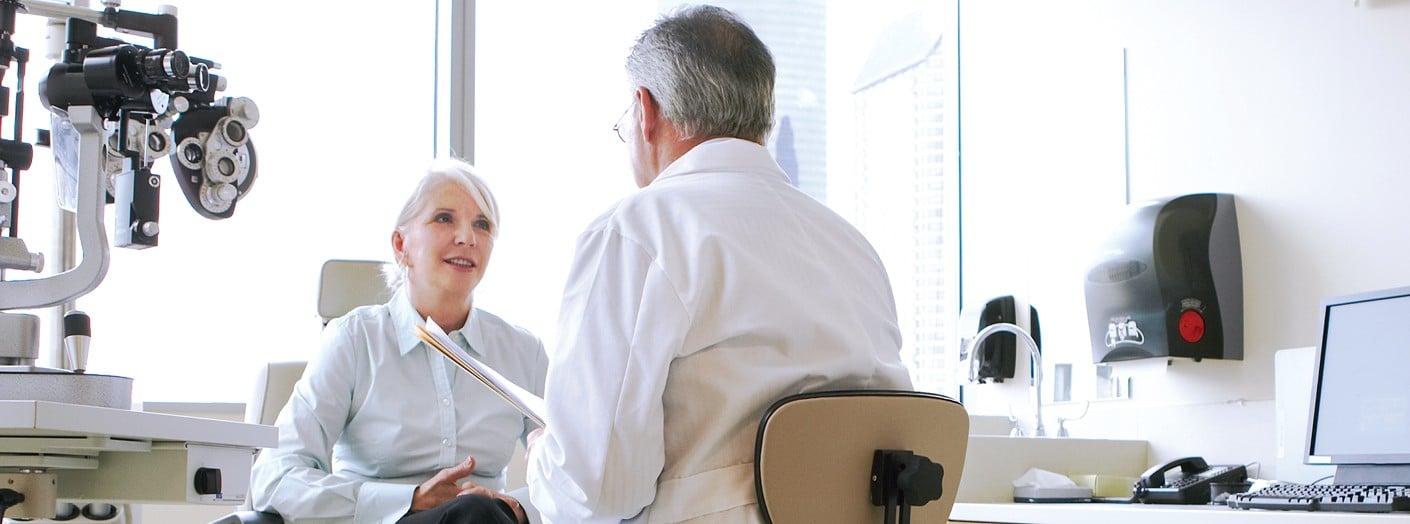What Is Glaucoma?
Glaucoma, referred to as the “sneak thief of sight,” is an ocular condition that causes permanent, irreversible vision loss.
The optic nerve, which is responsible for sending signals from the back of the eye or retina to the brain, is no longer able to function properly in glaucoma, causing vision loss. Vision loss caused by optic nerve damage is not treatable. However, if glaucoma is caught early, doctors can slow down and even stop optic nerve damage and vision loss.
Because glaucoma is uncovered during a comprehensive eye exam, attending regular exams is key to preventing vision loss from glaucoma. Vision loss in glaucoma starts in the periphery and moves over time towards central vision. Glaucoma has little to no symptoms until vision loss occurs, so it is important to attend regular eye exams.
Glaucoma Symptoms
While the most common form of glaucoma does not show symptoms other than vision loss, a rare type, called acute angle-closure glaucoma, does have symptoms. Acute angle-closure glaucoma is serious and is considered a medical emergency. If you notice any of the following symptoms, contact your ophthalmologist immediately:
- Eye pain
- Nausea
- Sudden visual disturbances
- Severe headache
- Eye redness
Glaucoma Risk Factors
While high eye pressure is the most important risk factor for the development and progression of glaucoma, it is still only one of many. Some other risk factors include:
- Diabetes and related diabetic eye conditions
- High levels of myopia
- Trauma to the eye
- Steroid use
- Individuals who have a family history of glaucoma
- African Americans over the age of 40
What Are the Different Types of Glaucoma?
While there are many types of glaucoma, they can be broadly broken up into two categories:
Narrow-Angle Glaucoma
The drainage system of the eye is located between the cornea and the iris (colored part of your eye). When the angle between these structures is narrowed or closed, the intraocular pressure (IOP) may suddenly rise, causing damage to the drainage structures and the optic nerve. The treatment of narrow-angle glaucoma is laser iridotomy (LI). The laser makes a small opening in the iris. This laser opening allows the angle to open and the (aqueous) fluid inside the eye to flow out of the eye’s drainage system into the blood circulation. This is usually an office procedure. Other than some mild discomfort, regular activities may be resumed shortly after the procedure.
Open-Angle Glaucoma
In open angle glaucoma the drainage system in the angle appears normal or open but damage to the optic nerve has occurred due to elevated IOP, or other factors. Treatment options include topical drops, laser therapy, and incisional glaucoma surgery. Initial treatment typically requires topical glaucoma drops or Selective Laser Trabeculoplasty (SLT).
Glaucoma drops require regular use to be effective. SLT laser is usually an office procedure with only mild discomfort, and patients can resume regular activities shortly after the procedure. OCLI doctors have helped pioneer microinvasive glaucoma surgery which involves placing an extraordinarily small and safe drain into the eye at the time of cataract surgery which can reduce or even eliminate the need for glaucoma drops.
If intraocular pressure (IOP) remains uncontrolled by glaucoma drops and SLT, incisional surgery could be the next option. Incisional surgery lowers IOP most effectively. With all surgeries, the risks, benefits, alternatives, and complications must be assessed with a qualified, trained physician prior to deciding which treatment is best.
Glaucoma Testing
Individuals at risk for glaucoma should have frequent, routine eye examinations to help detect glaucoma. The trained glaucoma experts at OCLI use a variety of special glaucoma tests to test the eyes’ drainage angle (gonioscopy), measure eye pressure (tonometry), evaluate the optic nerve (ophthalmoscopy), and test visual fields (perimetry). Information gathered during these evaluations is compared over time at regular intervals to evaluate how the glaucoma has progressed.
An intraocular Pressure Check (Tonometry) measures intraocular pressure (IOP) and is used to aid in the diagnosis and detection of glaucoma. For this test, an ophthalmologist or technician uses eye drops to numb a patient’s eyes before using a special device to measure IOP. This test is painless and only takes a few seconds to complete.
During an Optic Nerve Examination (Ophthalmoscopy), an ophthalmologist examines the inside of the eye, focusing on the optic nerve and retina. For this test, the nerve is examined through the pupil. This allows the ophthalmologist to note the color and shape of the optic nerve. If there is an unusual color or shape to the optic nerve, the ophthalmologist will perform additional tests to further evaluate optic nerve function.
Drainage Angle Inspection (Gonioscopy) determines if the area where fluid drains of out of the eye is open or closed. If this area, called the drainage angle, is damaged, blocked, or clogged, pressure may increase within the eye, causing optic nerve damage.
Visual Field Evaluation (Perimetry) measures the visual field including peripheral vision to reveal areas of vision loss. A decrease in the visual field is often an early glaucoma sign.
Glaucoma Treatments
At OCLI, our doctors are committed to providing the best glaucoma care medicine has to offer. The aim of glaucoma treatment is to slow or stop the progression of vision loss.
Common treatments for glaucoma include eye drops, oral medications, laser therapy, and surgical options. Please feel free to visit our Glaucoma Treatments page for more information.
If you are due for an eye exam, or if you have been diagnosed with glaucoma, OCLI is here to help. Call 1-866-SEE-OCLI today for your comprehensive eye examination!
Reviewed by Eric D. Donnenfeld, MD




















































